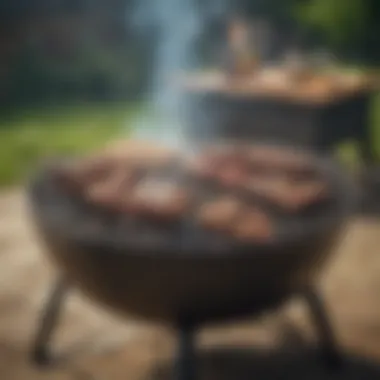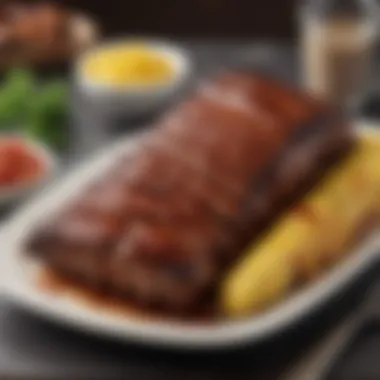BBQ Guys in Chicago: A Comprehensive Overview


Intro
Chicago is known for many things, including its deep-dish pizza, vibrant neighborhoods, and, of course, its barbecue. The relationship between Chicago and barbecue is richer than most may realize. This city is not just a backdrop for grilling; it has developed a unique BBQ culture intertwined with history, local flavors, and dedicated enthusiasts.
In this article, we will explore the landscape of barbecue in Chicago, covering various aspects that contribute to its identity. From traditional techniques to modern innovations, we will highlight essential establishments, equipment, and the community of pitmasters who keep the BBQ spirit alive. By delving into these elements, readers can gain valuable insights into what makes Chicago a true BBQ haven.
In the following sections, we will shed light on key topics. We’ll discuss the history of BBQ in Chicago, the popular BBQ styles, and evaluate the notable eateries well-loved by the community. We will also look at the essential BBQ equipment that every aspiring pitmaster should consider. Finally, we will share insights into local BBQ events and offer practical tips for those looking to hone their grilling skills.
Through this comprehensive overview, we encourage anyone with a passion for food to understand and appreciate how BBQ has evolved within the context of this illustrious city. Chicago's BBQ scene is vibrant, diverse, and worth exploring.
Intro to BBQ in Chicago
Barbecue culture in Chicago stirs a deep pride among its enthusiasts. This city, known for its vibrant culinary scene, showcases unique flavors and techniques that appeal to many food lovers. Understanding BBQ in Chicago is essential as it offers insights not just into local preferences but also into the rich historical backdrop that influences today’s cooking styles.
Historical Context
BBQ in Chicago traces its roots back to the early 19th century. Originally, smoked meats were cooked primarily for preservation, given the lack of refrigeration. Pioneers and settlers would cook meats over open flames, fostering a communal spirit that drew people together around food. As time went on, different regions contributed their traditions to the mix. The advent of the railroad also influenced the fast growth of meat markets, allowing for various cuts to become more accessible. Today, Chicago's BBQ scene reflects these historical influences while integrating new techniques and flavors. The establishment of BBQ joints like Smoque BBQ demonstrates how historical context continues to shape modern practices.
Cultural Significance
BBQ in Chicago transcends mere food preparation. It has become a cultural phenomenon, intertwining with social events and community gatherings. People come together during BBQ cookouts, forming bonds over shared meals. This aspect of BBQ fosters a sense of belonging, especially in a diverse city like Chicago. Additionally, events such as the Chicago BBQ Festival celebrate this culinary tradition and highlight the city's barbeque diversity. The cultural significance of BBQ is also observed in local competitions that engage both amateur and professional pitmasters, showcasing skill and creativity. This reflects Chicago's identity as a hub for culinary innovation while respecting its historical roots.
Defining BBQ Styles
Defining BBQ styles is crucial in understanding the diverse landscape of barbecue culture in Chicago. Each style encompasses its own set of techniques, flavors, and traditions that reflect the vibrant culinary fabric of the city. By exploring various BBQ styles, one can appreciate the factors that shape individual preferences and experiences with barbecue. This not only enhances the culinary enjoyment but also leads to a deeper understanding of the cultural influences that have shaped BBQ in Chicago.
Regional Varieties
The regional varieties of BBQ represent a broad spectrum of taste and preparation methods across the United States and, by extension, in Chicago. These styles range from the tangy-sweet flavors of Kansas City to the smoky and spicy profiles of Texas barbecue. Chicago has adopted elements from these diverse styles, blending them to create a unique local interpretation. The influence of the Midwestern palate is obvious, as many BBQ establishments emphasize tenderness and richness, often using a variety of meats, from ribs to brisket and sausage.
Local variations may also include Chicago’s own sweet and spicy sauces that maintain a balance between the tang and heat, creating an immersive experience for barbecue enthusiasts.
Cooking Techniques
Cooking techniques in BBQ significantly impact flavor and texture. BBQ cooking methods differentiate themselves through their approach, equipment, and patience required during preparation. Understanding these techniques can enhance the barbecue experience and enrich one's culinary skills.
Low and Slow Cooking
Low and slow cooking is a hallmark of American barbecue. This technique involves cooking meat at lower temperatures for extended periods, often exceeding several hours. The key characteristic here is time; it allows flavors to meld and meat to tenderize during the cooking process. This method is beneficial as it enhances the depth of smoke flavor while breaking down tough meat fibers, resulting in incredibly tender bites.
The unique feature of low and slow cooking is its reliance on patience and temperature control. While it can demand considerable preparation time, the outcomes are frequently praised, making it a popular choice in many BBQ establishments in Chicago. However, one disadvantage might be the time commitment it requires, which can be challenging for those who prefer quicker meal prep.
Grilling vs. Smoking
Grilling and smoking represent two distinct yet equally compelling techniques within BBQ. Grilling typically involves cooking meat over direct heat, yielding quick results with a signature char. Smoking, on the other hand, involves indirect heat with wood smoke, allowing for a gradual infusion of flavor.
This contrast of methods highlights the importance of preparation time and flavor profiles. The brief cooking time of grilling appeals to those seeking fast meals, while smoking captivates those who appreciate a deeper flavor complexity. An advantage of grilling is the speed with which one can prepare meals, making it a favored choice for casual gatherings. Conversely, smoking can require more time, but its depth of flavor makes it irresistible for dedicated BBQ enthusiasts.
Use of Marinades and Rubs
Marinades and rubs play a pivotal role in BBQ, influencing flavor before the cooking process even begins. Marinades typically consist of a mixture of acids, oils, and spices that infuse their own flavors into meat, while dry rubs consist of a blend of spices and seasonings that create a flavorful crust.
The key characteristic of using marinades and rubs is their ability to enhance the meat's natural flavors while introducing new ones. This technique is beneficial for both amateur and experienced pitmasters alike, as it allows for creativity and adaptability in recipes.
A unique feature of marinades is that they can contribute moisture and tenderness during cooking, particularly for lean meats. However, a disadvantage is that they may require additional planning time and certain ingredients. Rubs, in contrast, offer immediate flavor enhancement without the need for soaking time, though they may lack the depth of flavor that marinated meats possess.
In summary, knowledge of BBQ styles and cooking techniques can bring about a richer barbecue experience. Each method, whether it be grilling, smoking, or the use of marinades and rubs, contributes unique flavors and textures that shape the dining experience for BBQ lovers.


"Understanding BBQ styles and techniques makes for better tasting food and enhances the overall culinary journey."
Notable BBQ Establishments in Chicago
The landscape of barbecue in Chicago is shaped significantly by its notable establishments. These venues not only serve as dining spots but also as cultural hubs where BBQ enthusiasts come together. The variety of themes and styles among these establishments reflect the diversity of BBQ culture itself. By examining these places, readers can appreciate the city's unique offerings and understand why certain restaurants have garnered a loyal following.
Classic BBQ Joints
Eating House
Eating House is a standout in the classic BBQ scene of Chicago. This establishment is known for its traditional approach to barbecue, focusing on slow-cooked meats that are full of flavor. The key characteristic of Eating House is its commitment to quality. They use locally sourced ingredients where possible, enhancing the freshness of their dishes. This is why it is a cherished choice for locals and new visitors alike.
One unique feature of Eating House is their homemade sauces which complement their BBQ perfectly. The options range from tangy to sweet, accommodating a variety of palates. Potential disadvantages might include longer wait times during peak hours. However, many regulars consider the results to be worth it.
Smoque BBQ
Smoque BBQ is another classic joint that has made a significant impact in the Chicago BBQ scene. Their brand is synonymous with smoky flavors and expertly prepared meats. A defining aspect of Smoque BBQ is their focus on authenticity. They apply time-tested methods, ensuring that every bite captures the essence of traditional BBQ. This makes it a favored spot among those seeking genuine taste.
A notable feature of Smoque BBQ is their brisket, which is often commended for its tenderness and rich flavor. While it remains popular, some customers note that the prices are higher than other BBQ places. Nonetheless, many agree that the quality justifies the expense.
Emerging BBQ Outlets
Smoke Daddy
The BBQ scene is also evolving with emerging outlets like Smoke Daddy. This establishment is recognized for its innovative twist on BBQ. Blending traditional techniques with modern influences, Smoke Daddy brings something unique to the table. It caters to a younger demographic that appreciates both taste and creativity in food.
A defining characteristic is the variety of smoked meats offered, paired with unexpected sides and sauces. The combination of flavors invites exploration. One advantage of Smoke Daddy is its vibrant atmosphere, which appeals to group dining. However, some diners find the eclectic menu a little overwhelming.
Barbecue Pit Stop
Barbecue Pit Stop has been gaining attention as an emerging BBQ destination. Known for its fast-casual style, it balances quality with convenience. The highlight of Barbecue Pit Stop is its focus on customer service, striving to create a welcoming environment. This makes it a beneficial choice for families or individuals looking for a quick but satisfying meal.
A unique feature of Barbecue Pit Stop is its rotating flavors every week, keeping the menu fresh and exciting. While it may not achieve the same level of authenticity as some older joints, its innovative approach keeps it relevant. A consideration for customers is parking, which may pose a challenge in busy periods.
Essential BBQ Equipment
Understanding the role of equipment is vital for anyone wishing to elevate their BBQ game. Without the right tools, it's difficult to achieve the desired results consistently. This section delves into key pieces of equipment that enhance the BBQ experience in Chicago, focusing on functionality, benefits, and necessary considerations.
Grills vs. Smokers
Grills and smokers serve distinct purposes in the world of BBQ. A grill is often seen as a staple, catering to quick cooking at high temperatures. It is ideal for searing meats and achieving that classic grill mark. On the other hand, smokers focus on low and slow cooking, allowing flavors to deepen through long periods of exposure to smoke. Both have their unique advantages, and the choice between them depends on personal preferences and the type of BBQ experience one seeks.
Temperature Control Tools
Temperature control is crucial in BBQ. Proper heat management can make the difference between tender meat and overcooked disaster. Understanding how to utilize these tools effectively can significantly enhance the BBQ experience.
Thermometers
Thermometers are essential for maintaining precise temperatures while cooking. They allow the pitmaster to monitor internal meat temperature, ensuring food safety and optimal doneness. Digital thermometers provide quick readings, making them a popular choice among BBQ enthusiasts.
The main characteristic of thermometers is accuracy. High-quality thermometers often come with features like instant read technology, which can confirm the meat is cooked perfectly without needing to guess. One must consider durability and response time when choosing a thermometer.
However, using a thermometer requires some knowledge. Not all meats cook at the same rate or need the same internal temperature, which can create confusion if not understood correctly.
Fans and Dampers
Fans and dampers play a significant role in controlling airflow within a smoker. Airflow influences temperature and smoke levels, two critical aspects of successful BBQ. Proper airflow can help maintain a steady temperature and ensure even cooking.
The key characteristic of fans is their ability to centralize heat by circulating air. This helps prevent hot spots and allows for better overall cooking. Dampers offer a manual way to control air movement, which allows users to adjust the intensity of the fire and the amount of smoke produced.


A unique feature of fans is their potential for automation. Some fans connect to temperature controllers, ensuring that the BBQ pit stays at an exact temperature without constant monitoring. However, they can be complex to set up and may require a learning curve to operate effectively.
Accessories for Better BBQ
Additional tools can enhance the BBQ process, providing both convenience and improving outcomes.
Chimney Starters
Chimney starters are especially useful for those using charcoal grills. They enable a quick and effective ignition of charcoal without the need for lighter fluid, which can impart unwanted flavors into the food. The starter promotes even lighting of coals, making it easier to achieve the right temperature for cooking.
The noteworthy aspect of chimney starters is their simplicity. Users fill the top chamber with charcoal and ignite paper or kindling in the bottom. In a short time, the coals are ready for use. The convenience they offer makes them a popular choice for grillers.
However, they do require some preparation and may not be suitable for all types of grills, especially those that do not use charcoal.
Grilling Tools
Grilling tools like spatulas, tongs, and basting brushes are fundamental for any BBQ setup. They support the cooking process, making it easier to handle meats safely and efficiently. High-quality tools can last for many grilling seasons, providing excellent return on investment.
The main characteristic of these tools is their specialized designs. For example, long-handled spatulas prevent burns and allow for flipping heavy meats easily. A durable brush is essential for applying sauces or marinades evenly, enhancing flavor without over-saturation.
While the benefits of quality grilling tools are clear, they can vary widely in price and build quality, making it necessary to choose wisely to suit personal preference and frequency of use.
Dining While BBQing
Dining while BBQing is more than just a meal; it encapsulates a cultural experience and culinary tradition. When gathered around the grill or smoker, the atmosphere fosters connection and enjoyment. The smells of meats cooking, the sounds of sizzling fat, and the conversations between friends and family enhance the overall BBQ experience. It serves not just to satiate one’s hunger, but also to create lasting memories.
Popular Sides and Sauces
Sides and sauces are essential components in the barbecue dining experience. They complement the main meats, providing balance and variety. Popular sides vary widely, but certain dishes remain staples in Chicago’s BBQ scene.
Some common sides include:
- Coleslaw: A must-have, its crunch and tanginess balance the rich flavors of smoked meat.
- Macaroni and Cheese: This creamy dish adds a comfort-food element.
- Cornbread: Sweet and moist, it pairs well with savory barbecue sauces.
- Baked Beans: Often infused with flavors like bacon and brown sugar, they provide a sweet contrast to meats.
Sauces, on the other hand, can significantly affect the dining experience. In Chicago, you’ll find a mix of styles, such as:
- Tomato-based sauces: Sweet and tangy, commonly used in many BBQ spots.
- Vinegar-based sauces: These offer a sharp contrast, enhancing meat flavors without overwhelming them.
- Mustard sauces: Especially popular in certain regions, they deliver a unique taste.
The right side dishes and sauces not only enhance the meal but also invite the opportunity to explore different tastes that each establishment offers. Thus, diners should be encouraged to experiment and find pairings that suit their palate.
Pairing Drinks with BBQ
Proper drink pairings elevate the BBQ experience further. There are various drink options to complement the flavors of BBQ. Here are a few recommendations:
- Beer: Light lagers and IPAs work well with smoked meats for their refreshing qualities.
- Red wine: Full-bodied varieties, like Zinfandel, can complement rich barbecue flavors.
- Iced tea: Unsweetened options are favored, as they provide a refreshing palate cleanser.
- Cocktails: Drinks like whiskey sours or bourbon-based cocktails can harmonize with the smokiness of the meat.
When selecting drinks, consider the fat content and spice level in the meats. For example, a spicy barbecue may pair well with a sweeter drink to ease the heat. Similarly, rich and fatty cuts can benefit from acidic or bitter beverages that cut through the richness.
By understanding the art of dining while BBQing, enthusiasts can create memorable culinary experiences that bring together flavors, scents, and social interactions.
BBQ Events and Competitions
BBQ events and competitions are essential elements in the vibrant landscape of barbecue culture in Chicago. They serve as platforms for both seasoned pitmasters and novice grillers to showcase their skills and passion for BBQ. These gatherings foster camaraderie among enthusiasts and create an engaging environment for those who love barbecue. Furthermore, they provide a sense of community, nurturing a collective identity among BBQ lovers.
Annual BBQ Festivals
Annual BBQ festivals in Chicago attract large crowds and feature a variety of activities. These events celebrate the unique flavors and techniques that the city has to offer. Local restaurants often participate, bringing their best dishes for sampling. Festivals include live music, cooking demonstrations, and kid-friendly activities, enhancing the experience for all attendees. One prominent example is the Chicago BBQ Festival, which highlights not only the food but also the talent behind the grills.
The food aspect of these festivals is particularly significant. Attendees can try a wide range of BBQ styles, from traditional Southern BBQ to Chicago's unique takes. It provides an opportunity for participants to experiment with new recipes and gain inspiration from others. Festivals often include competitions such as rib-eating contests, allowing audiences to get involved.


Local BBQ Competitions
Local BBQ competitions allow pitmasters to test their mettle against each other. These events are typically organized by community groups, cooking clubs, or BBQ associations. Competitions generally focus on several categories, including ribs, chicken, and brisket. Prizes can range from trophies to cash awards. Participating in these competitions is more than just winning; it's about gaining recognition and respect within the BBQ community.
Competitors often spend weeks preparing for these events. They refine their recipes, adjust their techniques, and practice their timing. The competition environment also encourages learning and collaboration. Participants share tips and tricks, contributing to a culture of continuous improvement. Many local competitions follow Kansas City Barbecue Society or Memphis Barbecue Network guidelines. This standardization ensures a level playing field and enhances the competitiveness of each event.
"Engagement in BBQ competitions not only showcases skills but also strengthens bonds between pitmasters and teams."
In summary, BBQ events and competitions in Chicago play a crucial role not only in promoting the art of barbecue but also in building and nurturing a community of enthusiasts. They are significant in uniting people through a shared love for BBQ while allowing for the exploration of diverse flavors and techniques.
Tips for Aspiring Pitmasters
The journey into the world of barbecue is both exciting and daunting, especially for those who aspire to be great pitmasters. This section addresses critical aspects that every budding enthusiast should think about. Understanding these topics not only builds a solid foundation but also enhances the overall BBQ experience. Mastery in barbecue is a blend of knowledge, skills, and passion. Aspiring pitmasters should consider the nuances that go into crafting perfect barbecue dishes.
Choosing the Right Meat
Selecting the proper meat is fundamental for any BBQ venture. The right cut can make or break the outcome. Different meats have unique textures and flavor profiles, affecting how they should be cooked.
- Pork: This is often the most popular choice, especially ribs and pulled pork. They are suitable for slow cooking, absorbing flavors well.
- Beef: Cuts like brisket require more time but reward the cook with rich flavor. Knowledge of marbling is key here as it contributes to tenderness.
- Chicken: Often underrated, poultry can benefit from various marinades, enhancing its flavor.
Choosing fresh, high-quality meat ensures better results. Don't shy away from asking your butcher for advice.This will greatly benefit your BBQ endeavors.
Brining and Marinating Techniques
Brining and marination are crucial steps for infusing flavor and enhancing moisture in meats. Each has distinct purposes and yields different results.
- Brining: This technique involves soaking meat in a saltwater solution. It helps preserve moisture during cooking. A basic brine may include salt, sugar, and herbs. Here’s how:
- Marinating: Unlike brining, marinating focuses on flavor enhancement. Use acidic components like vinegar or lemon juice combined with oils and spices.
- A common ratio is 1 cup of salt in 1 gallon of water.
- Add spices and let the meat soak for several hours or overnight for best results.
- Aim for 30 minutes to a few hours of marination, depending on the meat.
- Avoid over-marinating as it can lead to tough meat.
Incorporating these methods can transform simple cuts into mouthwatering dishes.
Understanding Wood Types for Smoking
Wood selection is a crucial aspect of the smoking process. Different woods impart unique flavors to the meat, and understanding their characteristics is essential:
- Hickory: Provides a strong flavor, often used with pork and ribs.
- Mesquite: Known for its intense smoke, suitable for beef and game meats but can overpower delicate flavors.
- Applewood: Offers a mild, fruity note, perfect for poultry and pork.
- Cherrywood: This wood gives a subtle sweetness, ideal for a variety of meats.
Choosing the right wood enhances the overall barbecue experience. Maintain consistency in wood sourcing for balanced flavor across various grilling sessions.
"The key to successful barbecue lies in the details – from meat selection to cooking technique."
As you practice these tips, remember that barbecue is as much about technique as it is about personal taste. Embrace the learning process and refine your skills along the way.
Finale and Future of BBQ in Chicago
The BBQ scene in Chicago is rich and evolving. As BBQ continues to gain popularity, the future looks promising for enthusiasts and businesses alike. The cultural significance of BBQ not only highlights the city's culinary diversity but also fosters community connections. People come together to share meals and experiences that celebrate tradition while embracing innovation.
Trends to Watch
In the coming years, several trends are poised to shape Chicago’s BBQ landscape:
- Plant-Based BBQ: As diners become more health-conscious, interest in plant-based alternatives to traditional meats is rising. Many local establishments are experimenting with creative, smoke-infused vegetables and plant-based proteins.
- Global Influences: Chicago has a rich tapestry of cultures that influence local BBQ styles. Expect to see more fusion dishes that blend different culinary traditions, such as Asian-style BBQ ribs or Mediterranean spice rubs.
- Sustainability Practices: Consumers are increasingly aware of the environmental impact of meat consumption. Local BBQ joints are likely to adopt more sustainable practices, such as sourcing meat from local farms or using eco-friendly charcoal.
These trends signal a shift towards inclusivity and awareness within the BBQ community, reflecting broader societal changes.
Advancements in BBQ Techniques
Technology continues to advance, affecting how BBQ is prepared and enjoyed. Some notable advancements include:
- Smart Grilling Equipment: Devices like the Weber iGrill introduce digital thermometers that connect to smartphones, allowing pitmasters to monitor cooking temperatures remotely.
- Sous-Vide Cooking: More BBQ enthusiasts are using sous-vide methods to achieve perfect meat tenderness before finishing with a traditional smoke or grill. This technique ensures great flavor and consistent results.
- Specialized Wood Chips: The market is seeing growth in diverse wood smoking chips. From mesquite to applewood, these provide unique flavor profiles that pitmasters can easily incorporate into their BBQ.
*"The ongoing pursuit of excellence in BBQ techniques highlights the commitment of Chicago pitmasters to push the boundaries of flavor and preparation."















